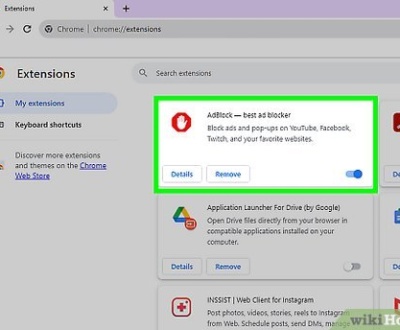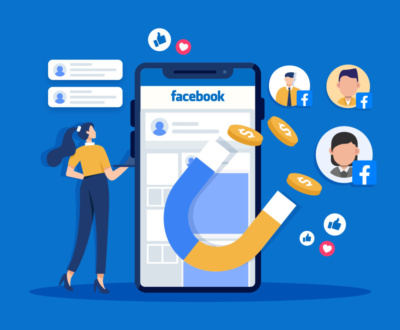How to use Facebook for Marketing
- November 13, 2022
- Digital Marketing, Facebook, Inbound Sales, Lead Generation, Outbound Sales, Sales, Social Media
Facebook for marketing isn’t optional. Facebook is the most used social platform in the world, pulling in 2.29 billion daily active users.
It’s not all vacation pics and humblebrags either. For 53.2% of internet users ages 16-24, social media is their primary source of brand research. And, 66% of all Facebook users check out a local business Page at least once a week.
Truth time: You need to be on Facebook.
But what should you do first? Do you need to run ads? What should you post about? Does creating a business Page mean you’re in the metaverse?
The answers to all your questions are ahead, plus a step-by-step process to start your Facebook marketing journey off right.
Table of Contents
- What is Facebook marketing?
- How to set up Facebook for business
- How to create a Facebook marketing strategy in 7 easy steps
- When to start using Facebook ads
- 8 types of Facebook posts to use for marketing
- 5 Facebook marketing tools
What is Facebook marketing?
Facebook marketing is the practice of promoting a business and brand on Facebook. It can help businesses build brand awareness, grow an online following, gather leads, and sell more products or services.
Facebook marketing tactics can include:
- Organic text, photo, or video content
- Paid, or “boosted,” text, photo, or video content
- Facebook Stories and Reels
- Facebook ads
- Facebook Groups
- Contests and giveaways
- Facebook Messenger chatbots or auto-responders
- Influencer marketing campaigns
How to set up Facebook for business
For those working with a limited or zero budget: You can do Facebook marketing completely for free.
Optionally, you can accelerate your growth with paid services, like Facebook ads, boosted content, or influencer/partnership campaigns. Facebook ads and Instagram ads in particular is where The Serial Seller is very strong, based on our hyper-targeted advertising strategy.
Let’s start at the beginning: Your business’ Facebook Page. Whether you only do this and share organic content, or follow the rest of the tips in this article, you need to have a Page.
Create a Facebook Business Page
1. Sign in to Facebook with your personal account. Your personal information won’t show on your Page, but you can also create a new Facebook account with a work email address if you prefer.
2. Open the menu (the nine dots on the right side) and click Create, then Page.
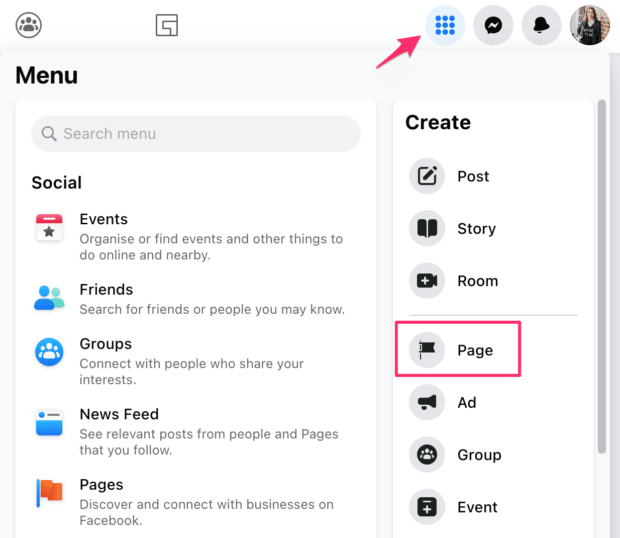
3. To create your Page, enter:
a. Name: Your business name
b. Category: Start typing to see the available options. For example, “retail” or “restaurant.”
c. Description: A sentence or two describing what your business does. You can edit this later.
4. Congrats! Your Page is live. Click Edit Page Info to add more to your About section, add a website URL, and more. I’ll cover exactly how to optimize your new Page later in this article.
Get verified on Facebook (optional)
You don’t need it, but it helps. How do you get that little blue checkmark like the cool brands?
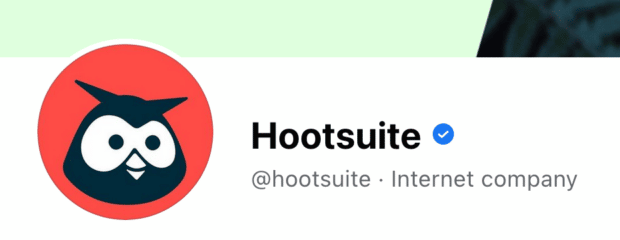
Verified Pages mean Facebook has checked to ensure the person or brand is who they say they are. It communicates trust (which is important since 72% of people say they distrust Facebook).
Technically, getting verified is as simple as filling out a form. But really, Facebook only verifies profiles and Pages belonging to businesses or well-known public figures.
It can be difficult to get a personal profile verified, but it’s quite easy for businesses of all sizes, especially if you have a physical location. The key is ensuring your proof of identity links are independent, non-promotional content from high-quality sources.
Open a Facebook ads account (optional)
It’s a good idea to set up a Facebook ads account even if you don’t plan to use it right away.
Once you have a business Page set up, go to Facebook Ads Manager (now part of Meta Business Suite). You can add an existing Facebook ads account or follow the prompts to create a new one.
Now you can start an automated campaign, create your own campaign from scratch, or promote (“boost”) existing Page content.
Not sure if you’re ready for Facebook ads? I’ve got tips on when and how to start later in this article.
How to create a Facebook marketing strategy in 7 easy steps
1. Define your audience
Before you do anything, you must first define who your ideal potential customer is and what they want on Facebook. Then, create a marketing and content strategy around that.
Every article about social media marketing says this.
…Because it’s true.
At minimum, you need to define your target audience by answering the following:
- What age range do they fall in?
- Where do they live?
- What types of jobs or job responsibilities do they have? (Most relevant for B2B brands.)
- What problem do they have with [your industry/product]? (And how are you the solution?)
- How and when do they use Facebook? (At work, home, doom scrolling before bed?)
Not sure where to start? If you already have followers on your Facebook Page, check out Audience Insights inside Meta Business Suite to see the demographics of your existing audience.
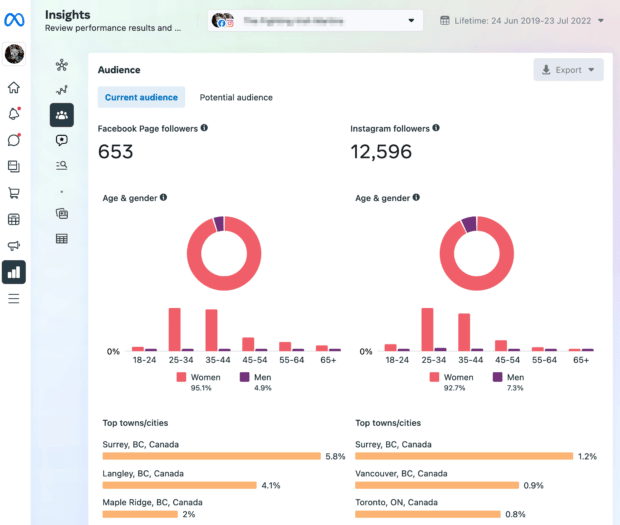
Meta’s Insights area offers more than basic info, including:
- Education attainment
- Relationship status
- Location
- Interests and hobbies
- Languages spoken
- Facebook usage statistics
- Past purchase activity
Does your data line up with the customers you want to attract? Perfect, keep up the good work. Not so much? Adjust your content strategy accordingly and watch your Insights to see what works for shifting your audience to the one you want.
This data is also valuable for ad targeting if you want to explore Facebook advertising.
Ready to dig deep? Here’s how to get all the nerdy info you want from Facebook Audience Insights.
2. Define your goals
Why do you want followers? What do you want them to do? For most companies, the answer is, “Buy something.”
But it’s not always about money. Other common goals for a Facebook Page are to:
- Build brand awareness
- Improve customer service
- Maintain a consistent brand image across social media
- Bring in traffic to a physical location
Your Facebook marketing goals will depend on your overall marketing strategy.
3. Plan your content strategy
No need to overcomplicate this. Your content strategy is:
- What you’ll post
- When you’ll post it
What to post
Will you share behind-the-scenes glimpses of your process? Will you post exclusive discounts? Will you stick to business, or include some fun and games?
Let your imagination run wild with ideas— Ha! Just kidding. You’re gonna post what your audience wants, right? From all that research you did in step 1, right?
Creativity is encouraged, though. Blend what you know about your target audience with what you think will perform well.
Think of your Facebook content strategy like buckets. Each bucket is a topic.
For example:
- Industry news
- Company news
- Tuesday Tips, where you share a short tutorial for your software
- Reviews/testimonials
- New products and promotions
You get the idea. And you know what makes everything, including creativity, more fun? Rules!
A few classic social media content strategy rules to consider:
- The rule of thirds: One third of your content is your ideas/stories, one third is direct interaction with your audience, and the last third is promotional content.
- The 80/20 rule: 80% of your content should inform, entertain, and educate, and the remaining 20% can be promotional.
When to post it
Once you’ve decided what to post, deciding when to post it is the last puzzle piece.
As mentioned earlier, Facebook Audience Insights can help here, although our research has found the best times to post on Facebook are between 8:00AM to 12:00PM on Tuesdays and Thursdays.
Not so fast. That’s a massive generalization. Like everything else in your strategy, experiment! Try different times and see when you get the most engagement.
It’s easy to stay on track with Buffer Publish. Everyone on your team can see upcoming posts, collaborate on drafts, and identify any gaps before you reach an oh-crap-I-need-a-post-right-now content emergency.
The best part? Buffer’s powerful analytics will tell you when the best times to post are, based on your personalized data.
4. Optimize your Page
Whether you’ve just set up your Facebook business Page or had one for awhile, make sure you have:
- A profile photo—your logo works great—and a cover photo. (Check our social media image size guide for current specs.)
- A call to action button, such as Book Now.
- Contact information, including URL, phone number, and an email address.
- A detailed about section.
- A pinned post with your latest promotion, offer, or FAQ.
- A custom Page URL. (For example: www.facebook.com/theserialseller)
- An accurate business category. (Ours is “Internet company.”)
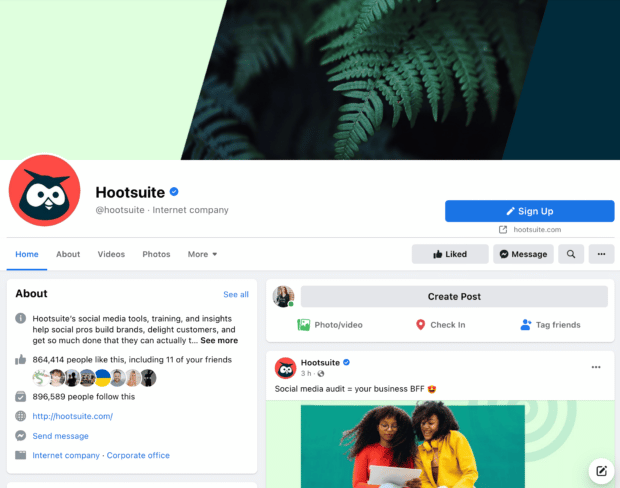
If you have a physical business location, also ensure you’ve added a street address.
If you’re an ecommerce business, use Commerce Manager to display your products in the new Facebook Shop tab. Not sure how? Here’s how to set up a Facebook Shop.
5. Try other Facebook tools
1. Create a Facebook Group
Groups require a lot of moderation and attention to be successful, but they can earn powerful results.
2. Drive engagement with Hootsuite Inbox
Hootsuite Inbox allows you to respond to DMs and comments from all your social platforms in one place. Besides replying faster, it also enables your entire team to manage communications without duplicating work or missing anything.
3. Try Facebook Marketplace for local sales
While you may think of Marketplace as simply the modern day replacement for Craigslist, it’s actually a powerful business sales channel, too.
In 2022, Facebook Marketplace ads reach a potential 562.1 million people. While most sellers are people cleaning out their basements, business listings are welcome, including in lucrative categories like car and real estate sales (where regional laws permit).
It’s free to create listings, making it a must-try for local businesses. If you sell nationally, consider promoting your shop website, too.
6. Install Meta Pixel (formerly Facebook Pixel)
Meta Pixel is a small piece of code installed on your website to allow tracking, testing, targeting, and analytics for Facebook and Instagram ads. You only have to set it up once per website.
To install Meta Pixel:
1. Log in to Facebook Events Manager. In the left menu, click Connect data sources.
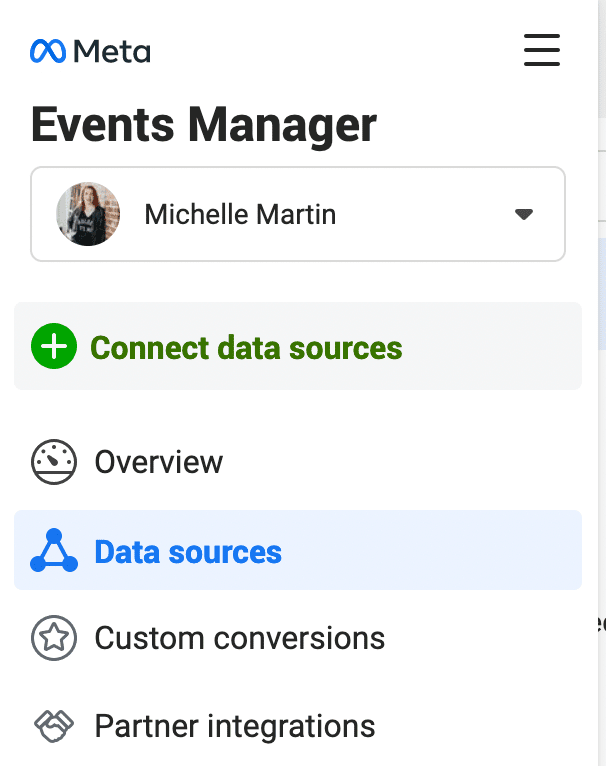
2. Choose Web as the data source and click Connect.
3. Name it and enter your website URL. Depending what your website runs on, there may be a one-click integration available. If not, follow the prompts to install the code manually.
4. Set up the events you want to track. From your Pixel’s Overview tab, click Add Events, then From the Pixel.
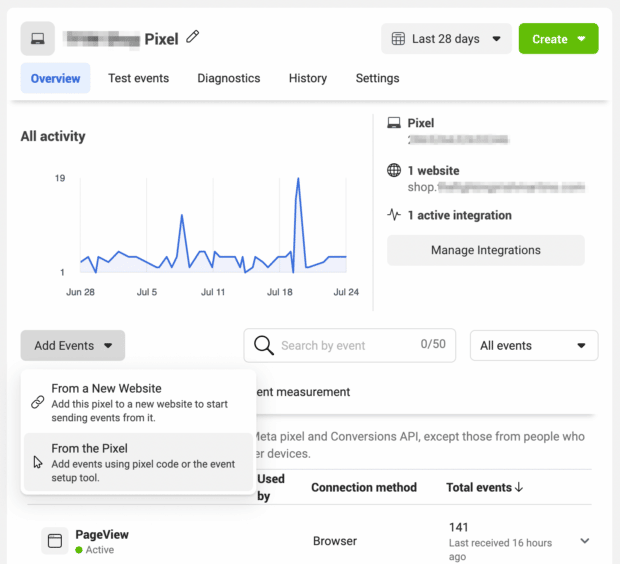
5. Enter your URL and click Open website. You’ll be able to select buttons on your site to track as an Event with your Pixel. No coding required. Assign each button a role, such as “Purchase,” “Contact,” “Search,” and more. Ensure your browser allows pop-ups for this to work properly.
7. Try Facebook advertising
Facebook ads can skyrocket traffic and sales, but launching a campaign can be overwhelming.
You’re also probably wondering how much Facebook ads cost. (Spoiler: It varies. You’re welcome.)
Facebook ads reach the largest potential audience of any social platform, up to 2.11 billion people as of 2022. Put another way, that’s 34.1% of Earth’s entire population over age 13.
If you want to begin social media advertising, Facebook is the best place to start for most businesses. There’s a lot to learn, but our step-by-step guide to creating your first Facebook ad campaign makes it easier.
But are you ready?
When to start using Facebook ads
The day after creating your shiny new business Page isn’t the best time to try out Facebook ads. But, letting someone else arbitrarily tell you when you’re ready isn’t the answer, either. Heh.
Yep, as with most marketing things, there isn’t one correct answer or KPI that can tell you when to start experimenting with ads.
I’d argue you should have these things first:
- At least 100 Page Likes (followers)
- Meta Pixel set up
- Clear Facebook marketing goals
- At least 20 Page posts (ideally more)
- Multiple creative assets for each ad
- An A/B testing strategy
The easy way: Boost a post
“Boosting” a post is Facebook lingo for taking a regular Page post and turning it into an ad.
Boosting is the gateway ad those senior content marketers warned you about. Side effects of success include conversions, audience growth, and a newfound appreciation for digital advertising.
When you should consider it: If you’re completely new to Facebook advertising and want to test the waters. Boosted posts are relatively cheap since you specify your budget up front. Remember: Cheap isn’t effective if the ad isn’t accurately targeted.
Ready to hit turbo mode? Here’s how to boost a Facebook post the right way.
The full monty: Create your first Facebook ad campaign
Ad groups, creative options, launch dates, awareness ads, conversion ads, multiple formats, copy options… A full Facebook ad campaign is a lot of work.
It’s worth it. The combination of organic and paid Facebook content is the secret sauce to achieving all your social media ✨dreams. ✨
When you should consider it: You want to build focused momentum for a product launch, event, or other promotion.
Paid campaigns can work with budgets of all sizes, but spend time honing your targeting skills first. Experimenting with boosted posts can help dial this in.
You know when you see an ad and think wow, I’m the target market! Like finding out A&W has kids-size meals at 5:30pm on a hot summer Sunday when I know my soul will leave my body if I turn the oven on.
That’s how you want your ad’s viewers to feel: “This is for me.”
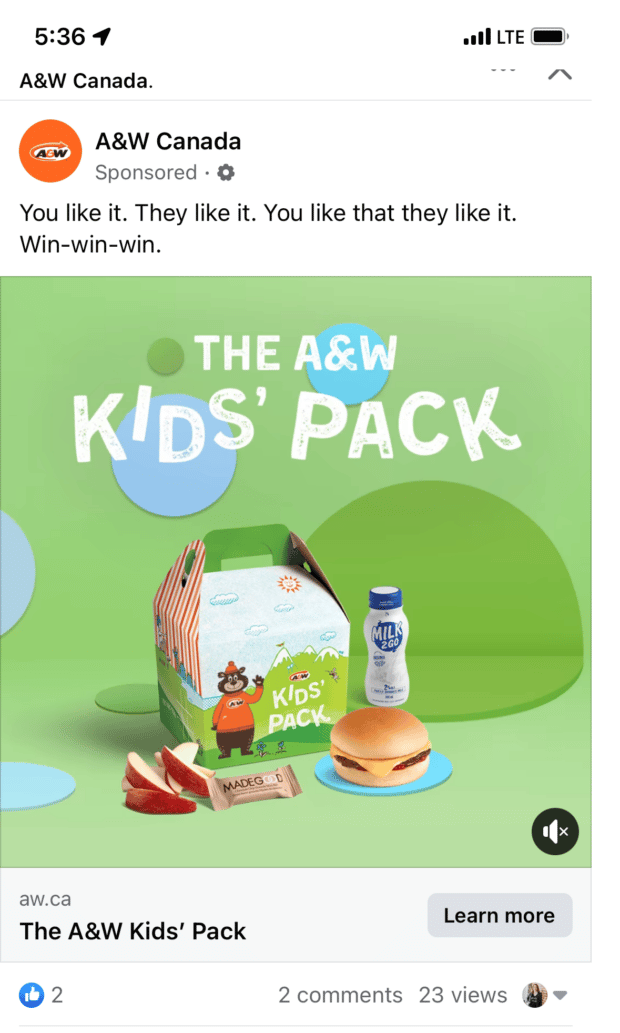
You can absolutely be successful at DIY-ing your Facebook ads, although plan to do a ton of research along the way. We have a few resources for you to start with:
- How to Advertise on Facebook: A Complete Guide
- Every Type of Facebook Ad You Should Be Using to Grow Your Business
- All the Facebook Ad Sizes You Need to Know in 2022
- 22 Facebook Ad Examples to Inspire Your Next Campaign
Consider hiring an agency or freelance consultant to help plan your first campaign. You’ll learn a lot and optimize your chances of success.
8 types of Facebook posts to use for marketing
1. Text
Plain Jane. All type and no hype. The OG.
Text posts don’t include links, so they’re not meant to drive traffic, but they can be surprisingly good at growing your Page audience. Text posts have the highest average engagement rate at 0.13%.
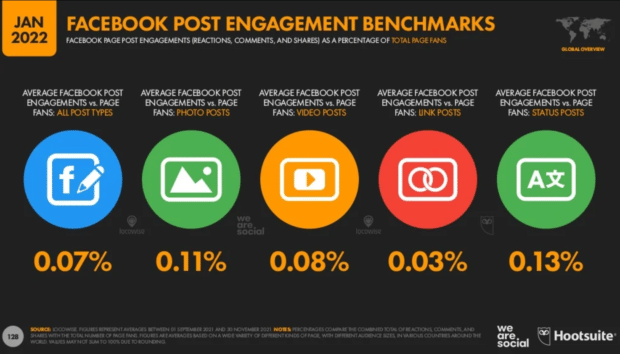
Source
However, these posts can easily get lost in the algorithm. For text posts under 130 characters, you can choose a colorful background to help them stand out.
Keep text posts short: Communicate something quickly to your audience, or ask them a question.
Or, be super relatable and funny.
2. Photo
Photo posts are second only to text posts for engagement, with an average engagement rate of 0.11%. A photo post can be any type of image, including a photo, infographic, or other artwork. You can add as many photos as you want to each post, but for 10 or more, consider creating an album instead.
Every type of business can make impactful photo posts:
- Show off your latest collection or share the process of making your products.
- Bring your audience into your office or workshop.
- Wow them with data visualizations to make your point.
Better yet, feature your customers’ photos for a unique perspective on your products and engage your audience, too.
Limited photography budget? Check out these free stock photo sites.
3. Video
Video communicates the way nothing else can. It’s the next best thing to having your audience right in front of you.
Stuck for ideas? Here are a few types of videos to share:
- Explainer videos
- Demo videos
- Interviews with industry experts, or your own team
- Behind-the-scenes sneak peeks
- Event coverage
- Products, either informally or a formal commercial shoot
- Webinar recordings
MojoGrip is a go-to resource for aviation fans. They know their audience is just as passionate about aircraft as they are, so this “How It’s Made” video was a big hit.
Wondering what successful social media videos have in common? Check out Hootesuite’s tips for creating viral social videos.
4. Live video
Using live video successfully is all about holding your audience’s attention.
Q&As are one of the most effective live video formats for B2B companies. For both B2B and B2C, try demo videos showing how to use your product, especially to show off lesser-known use cases or “hacks.”
Lenovo managed to engage their audience and show off a new product’s capabilities with this Live. Viewers voted on ways to try to destroy the laptop and Lenovo carried them out live to prove the computer’s toughness.
Not wondering what to talk about, just how to do it? We’ve got a Facebook live guide for newbies.
5. Links
Links = anything directing to an external source, like your website. Link posts can contain any type of media, too.
Creating one is easy: All you need is a caption of your own, then paste in any link and Facebook will pull in an image, title, and meta description from the website. Or, you can manually add your own.
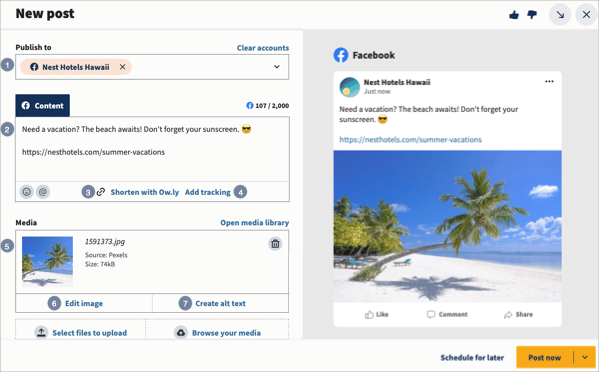
6. Facebook Stories
Every day, one billion Stories are posted across Facebook, Instagram, Messenger, and WhatsApp—Meta’s family of apps.
Facebook Stories offer a familiar vertical format and options for adding links, stickers, text, and more. You can use either an image or video. Images show for 5 seconds and videos can be up to 20 seconds per Story. All Facebook Stories disappear after 24 hours.
You can publish organic Stories, or make Facebook Stories ads.
For best results, keep text and graphics minimal and use the space to let your photo or video speak for itself.
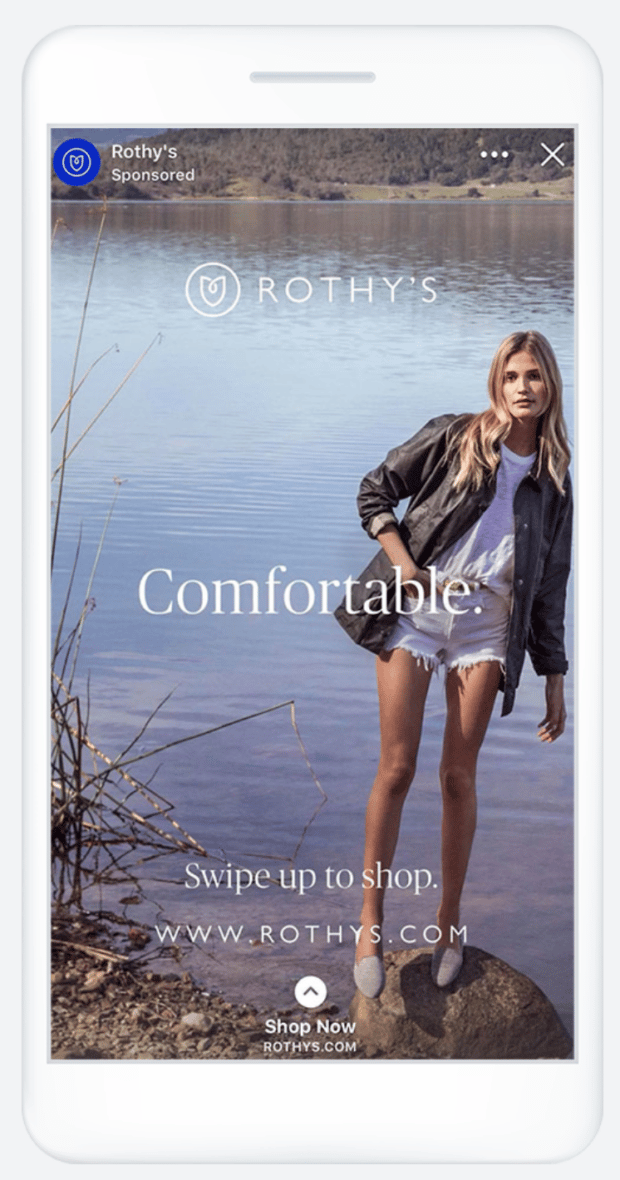
7. Pinned post
You can set an existing post on your Facebook Page as a “pinned post,” which means it will always be at the top of your Page.
This is helpful for a welcome message, links to important pages or customer support contacts, or anything you’re promoting right now. You can change your pinned post anytime.
McDonald’s changes theirs up frequently for new promotions, like this one encouraging app downloads.
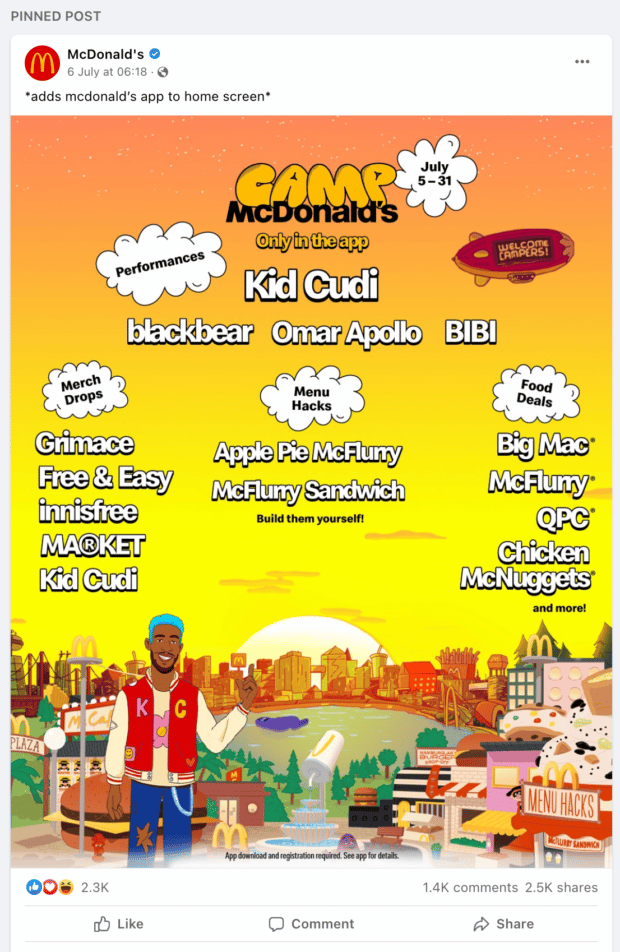
8. Specialty post types
These are great for specific cases, but you’ll use them less frequently.
Facebook Group posts
Running a members-only Facebook Group in addition to your business Page can be a lot of work. But if building a community is one of your goals, a Facebook Group is a perfect way to achieve that, thanks to its 1.8 billion active monthly users.
Posting in a Group is the same as posting to your Page, except it’s only visible to members. Think it would be a good fit? We’ve got step by step instructions, plus recommended settings, for creating a Facebook Group for business.
Hello Fresh runs their #FreshFam Group for customers to share photos and feedback of the recipes they made. It’s linked to their business Page under the Community tab.
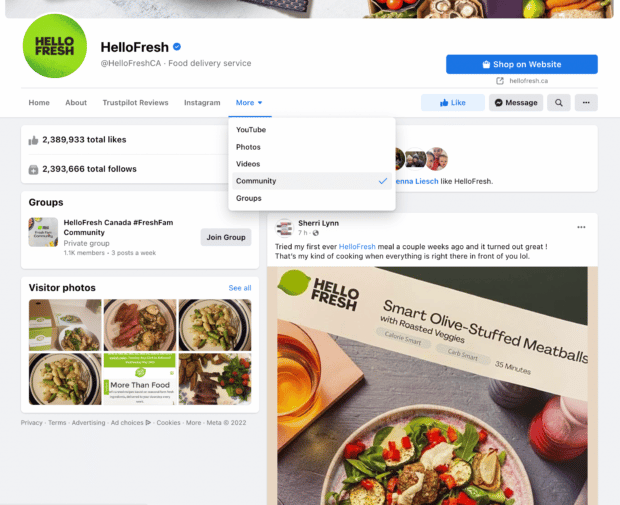
Fundraisers
Fundraising on Facebook for a charity, or your own foundation, is an excellent way to grow your audience while making a positive impact.
Fundraisers show your values and connect people to your brand’s purpose. It puts your money where your mouth is. Bonus points: You can opt to match all donations (up to a limit of your choice).
And of course, make your new fundraiser your pinned post to maximize views, like the Humane Society of the United States:
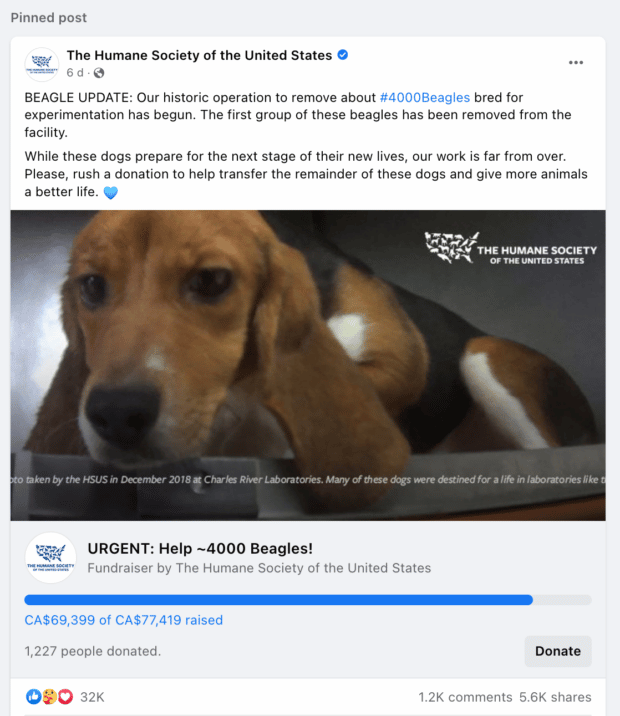
However, only verified Facebook business Pages for public figures, brands, or charities can create fundraisers.
There’s a workaround if you’re not verified yet, though. Create a fundraiser with a personal Facebook user profile, then share it on your business Page.
Events
Creating an event post has 6 unique benefits:
- It’s featured in a separate tab on your Page (“Events”).
- It’s listed in Facebook’s Events section, so people can discover you even if they don’t Like or follow your business Page. Over 35 million people use Facebook to find events near them every day.
- People can RSVP for both in-person or online events, so you can plan attendance.
- If someone doesn’t want to RSVP yet, they can click “Interested” and Facebook will remind them closer to the event.
- You can create Facebook ads for Events for more views.
- You can have multiple hosts, and it’s listed on all host Pages, so it’s easy to work with partners or influencers to promote it.
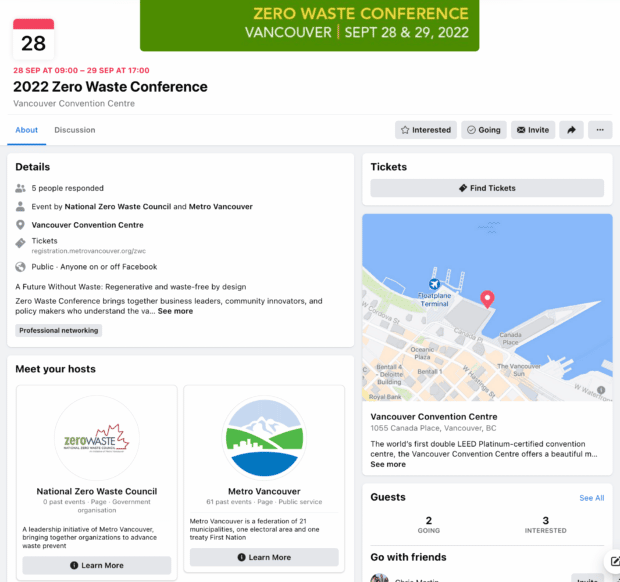
5 Facebook marketing tools
1. Hootsuite
With Hootsuite, you can manage all of your Facebook marketing activities from one place. We hate marketing clichés, but it really is your, excuse us, one-stop shop for all things Facebook marketing.
Use Hootsuite to:
- Schedule all of your Facebook posts in advance
- Identify the best times to post (when your unique audience is active online and most likely to engage with your content)
- Review your performance and easily generate comprehensive reports
- Answer comments and private messages
- Boost posts
- Easily track what people are saying about you online
- Manage your Facebook Pages alongside all your other social profiles on Instagram, TikTok, LinkedIn, Twitter, YouTube, Pinterest, and LinkedIn.
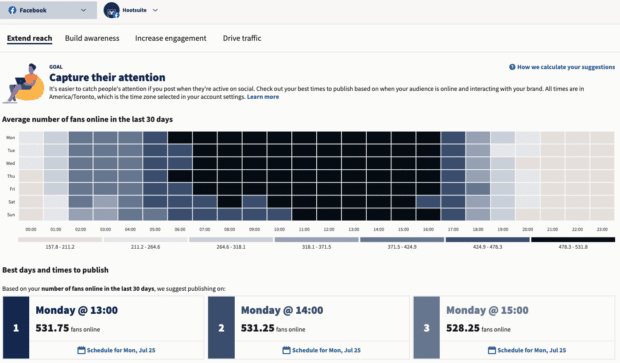
2. Heyday
Leverage AI to save money and provide top-notch customer service 24/7. Facebook Messenger chatbots can act as an interactive FAQ, as well as connect your customers to live agents for more complex requests. And, they can even suggest and sell products right from Messenger.
Ecommerce retailer Bestseller’s chatbot, powered by Heyday, automated up to 90% of their simple customer conversations in both English and French.
But more importantly, its smart programming understood Quebecois French terms—a rare and important feature for the Quebec-based company. They’d already found the generic French translations used by other apps unsuitable.

3. Chute
User-generated content is awesome for 2 reasons:
- People are 2.4 times more likely to view it
- You don’t have to create it
Chute simplifies the often-daunting task of finding relevant content based on topic, location, or more. Save what you find into an organized content library you can access from Hootsuite Composer.
It also makes it easy to properly obtain usage rights and permission for legal compliance.
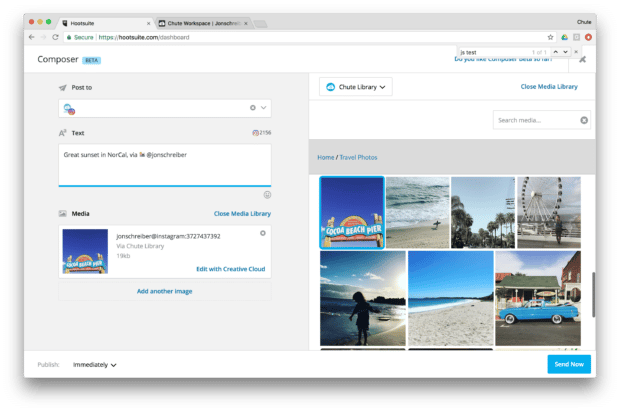
4. Reputology
Reviews are one of the most important aspects of your Facebook business Page (and elsewhere). Reputology tracks incoming reviews and allows you to respond inside Hootsuite.
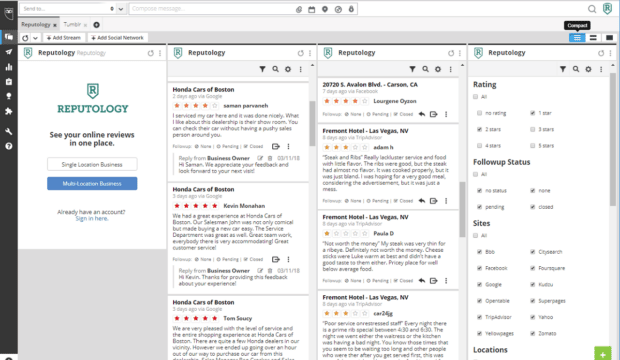
5. Facebook Ads Library
Sometimes a little inspiration is all you need. Facebook Ads Library is a searchable database of all the ads currently running on Facebook.
You can filter by location, type of ad, and keywords.
Get ideas for your next campaign, identify trending phrases or graphics, and check up on what your competitors are doing.
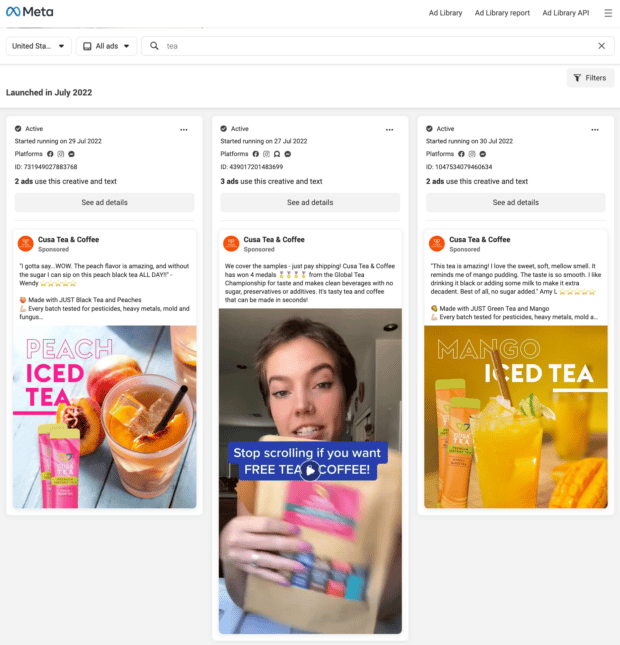
Want assistance with Facebook marketing? Book a Call with us now if you want assistance with Social Media Marketing or PPC Ads on Facebook.
About us and this blog
We are a Full-Service Sales & Marketing provider that aims to help small to medium businesses increase their leads and sales while helping remove the business owners from their day-to-day activities so they can focus more on the long-term goals of their business.
Book a Meeting with us!
We offer Done-For-You Sales, Sales Coaching, and Advisory as well as Digital Marketing Services. If you want to increase the leads generated for your business and need some guidance and accountability, book a call with us now.
Subscribe to our newsletter!
More from our blog
See all postsRecent Posts
- How Do You Stop Google Ads May 9, 2025
- How to Make Money Off Social Media May 5, 2025
- How to Duplicate Page WordPress May 1, 2025

